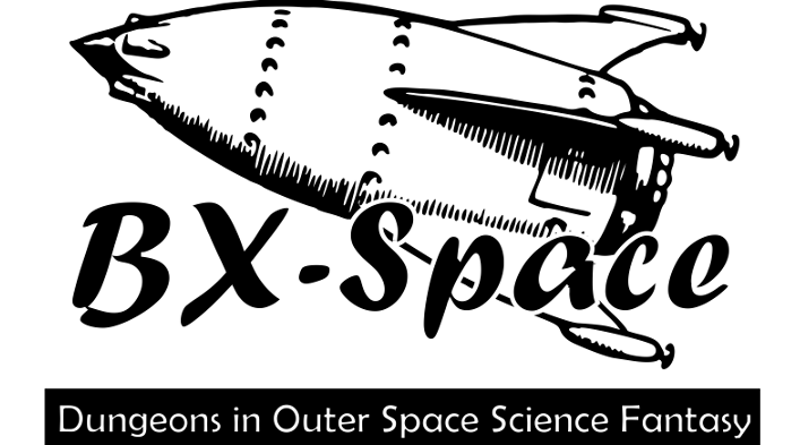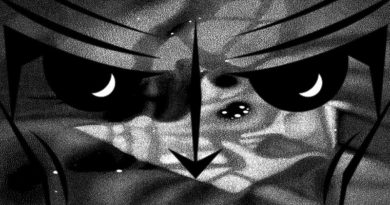BX-Space Rules Wrap Up
To recap, BX-Space is a humble supplement to known rules in the fantasy genre. I have tried to add only those rules necessary to transport dungeon adventures into space while leaving the groundwork already covered in known rules in place. Hopefully I have not managed to break anything, that is I have tried not to make spoilers such as Rayguns which have unlimited use or disintegrate foes in one go, these will not be found.
The BX-Space articles have been collated into a usable form for those readers who would like to give this supplement to known rules a try. At the end of the article you’ll find both a PDF and a LibreOffice document for easy editing and annotation. Of course this is submitted as open game content within the OGL which means it is reusable by anyone who follows the terms of the license. In other words this is contributed to the OSR in a spirit of openness.
This author won’t make any claim to be omniscient, if readers find typos or other inconsistencies please let me know and I will see what I can do to correct them.
The next article will reveal the Lair of the Space Pirates, and this introductory adventure describes what a medieval space dungeon adventure might be like.
BX-Space Alpha Test LibreOffice Document
Next Article – The Lair of the Space Pirates




2017-12-01 The files have been updated to v.01 of the Alpha Test.
The Rocket Ship Class table was missing a 2 in the header row superscript to tell the reader where the note belongs.
The Damage Table on Page 9, and Rocket Ship Class Table on page 24/25 have been updated to show that the intent is a ship’s cannon cause the same damage vs. ships and ship scale monsters as their Hit Dice Type which may be d4, d6, or d8 if variable dice are being used. Otherwise a ship cannon causes 1d6 damage.
In answer to one question, a ship’s Hit Dice Type may be d4, d6, or d8. That allows some variance for quality and advancement of construction, age of the ship etc. A ship’s class does not fix its Hit Dice. Type.
2017-12-03 The files have been updated to v.02 of the Alpha Test
Typographical changes:
The text of the Firing Mode Descriptions column has been changed from “may:” to “many:”
v.s. has been replaced with vs.
Good morning/evening Greg,
Firstly I’d like to say how amazed I am by the volume of quality, imaginative, and fun content you can produce. To use on old phrase, “I dips my lid to you”.
A couple of editorial questions/typos. I’ll use the pdf page numbers.
P9/P11 Damage paralysis. Man sized on one and Ogre sized on the other.
P9/P10 Ships Cannon occurs twice in the Weapon Damage table – 4d6 and then again later in the same table the variable by ships HD.
Weapon Cost and Weight – it was the “These” weapons that made me think there was more listed for the cleric – I love the idea of the cleric using both ray gun varieties – that does not feel inconsistent with the class limitations.
Question from my children P17 Damage from no air. 1d6 in 10 minutes of no air? They all tried holding their breath but couldn’t make 10 minutes :p Fun watching them try anyway.
Page 20; Can the “note 1” at the bottom of the table be applied to the tables on P21 & P62 please? I forgot what the (1) referred to.
P34: Table column 1 – the value 5 occurs twice. Is it 9-7, 6-5, 4-2?
P36 (as far as I got.) Pondering/puzzled by the Combat in N-Space description. My brain is a little slow to grasp new things. For the hard of thinking, am I close in this interpretation?
Refer to a Combat Sequence; in the Movement segment, ships have the opportunity to escape (see Escape Number p23). A PC at the Helm of the Rocket Ship can escape pursuit/conflict by successfully rolling their Check Number or better. The Player may fly slow, normal, or fast. (As in the Rocket will only be able to fly slow, normal or fast at its top speed? I am presuming it is not that the PC has elected to escape slowly)
● Slow: add +5% [+1] to the Dice Roll, add +1 to AC. (To the check number dice roll? Making escape more likely for a slow ship, while reducing the effectiveness of the AC let us say from 4 to 5?)
● Normal: no adjustment to dice roll or AC
● Fast: subtract -5% [-1] from the Dice Roll, deduct -1 from AC. (Making escape harder but also improving the AC?) They seem back to front for me if I’ve understood them correctly which is no sure thing.
AC may not be increased beyond 9, or reduced below -3. (to do with the escape speed?)
P56 Space Treasure Types: There are 26 numbered treasure types. The following table illustrates Space Treasure Types 22
through 26. Do the other 21 come from the traditional rules?
Cheers,
Glenn
Hi Glenn,
I’m glad you and your family are enjoying the material! 🙂 I’ll do my best to answer your questions:
Q: P9/P11 Damage paralysis. Man sized on one and Ogre sized on the other.
A: Well, isn’t my writing confusing, I’d go with Ogre sized and smaller.
Q: P9/P10 Ships Cannon occurs twice in the Weapon Damage table – 4d6 and then again later in the same table the variable by ships HD.
A: The first entry in the table on page 9 is meant to refer to the bombardment of surface objects from a flying ship, hence the Cannon attack is then treated as a “Blast”, such as the bombardment of the surface of an asteroid for example. Characters on the surface are entitled to a saving throw vs. Blast. Characters below ground level are protected from bombardment. The entry in the last row of the table is intended for ship vs. ship, or ship sized monsters.
Q: Weapon Cost and Weight – it was the “These” weapons that made me think there was more listed for the cleric – I love the idea of the cleric using both ray gun varieties – that does not feel inconsistent with the class limitations.
A: For other readers this is part of another discussion on Google+ and in the discussion there the possibility of a Cleric using a Blaster Ray Gun was raised. Sure, why not!
Q: Question from my children P17 Damage from no air. 1d6 in 10 minutes of no air? They all tried holding their breath but couldn’t make 10 minutes :p Fun watching them try anyway.
A: I’ll admit the rule isn’t very realistic. A Character wearing a space suit has run out of air and I wanted to give them a chance to get back to the ship. That is I didn’t want to deprive the character of their ability to take action. If a character perishes the game is over. In any event low level character’s won’t make it very far…
Q: Page 20; Can the “note 1” at the bottom of the table be applied to the tables on P21 & P62 please? I forgot what the (1) referred to.
A: The note at the bottom of the table on page 20 refers to the Damage Column, that is the results of Damage in that column as applied to Player Character Robots is optional. Other character classes, Fighters etc. do not lose any functional ability with damage. They can be at 1 HP and fight just as well. In keeping with this a Space Master should probably not reduce a Robot Player Character’s ability to use the Robot systems unless they want to make it much more difficult to play the robot character. Its a choice. As far as NPC Robots, yeah, its more interesting to make bashing them impact what they can do standard.
The (1) in brackets in the tables means one item.
The Robot equipment table on page 21 is meant to be somewhat equivalent to the regular equipment table but for Robots. It gives Player Robots something to spend their treasure on. It also allows players to buy spare or replacement parts for NPC Robots. Of course if your using the system damage rules for Player Robots they will need to buy spare and replacement parts from this table.
Page 62 is the Robot as an NPC Monster and the system damage rule is not necessarily optional for them. I need to take the 1 in superscript off of the 1 or put the note in here.
Q: P34: Table column 1 – the value 5 occurs twice. Is it 9-7, 6-5, 4-2?
A: Yes, its a typo, the GNs in the last row for a Planet should be 4-2.
Q: P36 (as far as I got.) Pondering/puzzled by the Combat in N-Space description. My brain is a little slow to grasp new things. For the hard of thinking, am I close in this interpretation?
Refer to a Combat Sequence; in the Movement segment, ships have the opportunity to escape (see Escape Number p23). A PC at the Helm of the Rocket Ship can escape pursuit/conflict by successfully rolling their Check Number or better. The Player may fly slow, normal, or fast. (As in the Rocket will only be able to fly slow, normal or fast at its top speed? I am presuming it is not that the PC has elected to escape slowly)
? Slow: add +5% [+1] to the Dice Roll, add +1 to AC. (To the check number dice roll? Making escape more likely for a slow ship, while reducing the effectiveness of the AC let us say from 4 to 5?)
? Normal: no adjustment to dice roll or AC
? Fast: subtract -5% [-1] from the Dice Roll, deduct -1 from AC. (Making escape harder but also improving the AC?) They seem back to front for me if I’ve understood them correctly which is no sure thing.
AC may not be increased beyond 9, or reduced below -3. (to do with the escape speed?)
A: My choice of language may not be the best here, I should have used something other than “Slow” and “Fast” as they are misleading and do not put over the intended concept. The exact position of the ships is never plotted, it is assumed that they are in proximity to one another for the purpose of attack. Combat takes place when one ship cannot escape the other. The intent of the helmsmanship is to allow a character to attempt to pilot their way out of combat in a movement phase prior to attack. The player is rolling vs. the other ship’s Escape Number (EN). The idea is whatever they do affects the Ship’s AC should their check roll fail. So, if the character takes evasive action (Fast) it reduces their AC but makes it more difficult to elude the pursuer because they must apply a deductive modifier to their dice roll. If they focus on escaping (Slow) they gain a bonus to their dice roll but their AC is lowered and their ship becomes easier to hit. Normal, simply roll vs. the EN.
I need to rephrase the terms Fast and Slow as degrees of “Risk”. It gives the player character a choice to weight the outcome somewhat. I have to think on that and come up with better terms.
Q: P56 Space Treasure Types: There are 26 numbered treasure types. The following table illustrates Space Treasure Types 22 through 26. Do the other 21 come from the traditional rules?
A: Yes, that is the intent of the table, draw the others from classic rules or known rules.
All the best,
Greg
Oh, I should probably say that the effect of the manoeuvering helmsman on AC should be that the AC of the ship is improved, unchanged, or worsened, depending upon their choice and the result of the check roll vs. the other ship’s, or ship scale monster’s, Escape Number (EN). The result of the modification to AC still has to stay within the range of AC values at the top of the table. That is it has to be at least achievable with an ordinary roll.
I think what I’ll do is revise that part of the ship combat text and provide an example of use so the idea is better presented.
Thank you very much for all of that Greg – have I grasped the combat with this? Trying to word it so accurate for both ascending and decending AC:
If the helmsman is focused on evasion, it is more difficult to outrun the pursuer and the PC applies a -1 penalty to their roll vs. the pursuer’s EN. Should the roll fail however, it improves their AC by 1 throughout the subsequent combat.
If the helmsman is focused on escaping, it is easier to outrun the pursuer and the PC applies a +1 bonus to their roll vs. the pursuer’s EN. Should the roll fail however, it penalises their AC by 1 throughout the subsequent combat.
Q. Do the pursued get another chance to roll vs. the EN after a combat round, or is it just fighting to the bitter end once the initial roll has failed?
HI Glenn,
Yes you have it correctly. I think I’ll change the wording to outrun and evasion respectively as those are good conceptual choices.
Yes, either party may attempt to leave a combat, if you are using the combat sequence from the basic rulebook, on page B24 is a combat sequence; the second entry is movement:
|2. Movement per round, meleed opponents may only move defensively (spell casters may not move and cast spells).”
So during the round either party may make a roll vs. EN and escape if they wish to leave the combat. Of course a “pursuer” need do nothing. Once a ship escapes a combat it is ended.
I have left open what further pursuit might mean, and whether the ships may encounter each other again. Players at a destination (planet) might state something like, we’ll search this destination for the fleeing pirate ship. The Players could then make a check roll to see if they find the fleeing pirate ship (assuming it hadn’t left the current destination); the Test Number could be applied vs. the opposing ships EN. Or, the Space Master might decide a roll of 1 on d6 is enough to encounter the ship again at that Destination. Using a Hyperdrive to leave a solar system would completely end a combat.
Of the two I think I prefer the aspect of using 1d6 for searching because its a simple mechanic, this dice type could be easily modified by the Space Master for special circumstances, maybe there’s clouds of gas, space junk, a crater to land and hide in, or asteroids to hide behind. The fun is in imagining what is happening without needing any props or knowing definitively where things are. The Space Master can change the dice type informally for circumstance, clouds of gas might make a ship far harder to find again, granting only a 1 in 8 chance of success. Any dice type from d4 through d12 could be used.
Having previously escaped a Pirate Ship hides…
Space Master: Having decided that an escaped pirate ship will hide in some asteroids and gives the players a 1 in 6 chance of finding it again.
Player: This Turn we’re searching for the escaped pirate ship! We’ll use the periscope.
Space Master: Roll 1d6.
Player: Rolling the dice, 1!
Space Master: You spot the enemy ship, its cleverly hiding behind an asteroid. Start a round of combat, roll for initiative!. The pirate wins initiative, the Space Master rolls to see if the Pirate escapes, the check roll vs. the Player Ship Escape Number fails, and the AC of the Pirate Ship increases by 1. The pirate tries to fly away but doesn’t succeed in escaping!
Player: We must have damaged their helm in that last attack. Fire the Cannon! One of the Players (A Fighter) makes the check roll, scores a hit, and rolls for damage. The pirate ships HP are reduced to zero by the attack.
Space Master: The Pirate ship is damaged, the rocket motor goes dead and the ship begins to drift.
Player: We’ll grapple the ship and board it! Everyone grab your gear!
Space Master: Make a Check Roll to grapple the Pirate Ship and draw it to the airlock…
Alpha Test version .03 has been released with updates along the lines of the discussion above with Glenn to clean up typos and text. Notable change, the Web Terror is a 3 HD Monster with an EN of 5. The Robot class damage table has been clarified to show that it is optional. The text of the Normal Space combat has been edited for clarity.
We played again tonight, but started a fresh adventure, rolled up space specific characters, two threadbare thieves and a robot washed up in this backwater where they started in the Baboo Cantina. Eventually they met Captain Hunter and his (t)rusty sidekick B9. Skip forward through the chatter of 3 9 and 12 year olds, they finish the night with one of the character defusing mines at the end of his space tether. Each mine has a panel on the front with 4 screws and each screw was 1 in 6 to explode. Sadly the first mine exploded on the 4th tension filled unscrewing however owing to the age of the mine it only did 3 points damage. Injuries not critical, a second mine was attempted, and after 4 anxious dice rolls it was disarmed and the code transmitted. End of part 1.
Boys all retired to bed (very late), thumbing through their BX Space handbooks.
Good fun so far although I really need to be more than half a page ahead of them.
G’day Greg,
Giant Brain saving as Magic User, but level missing.
Children dallying on Wolf Iron so I’m going to have a raiding party of lizard men arrive at one of the hidden airlocks on a scavenging raid and push the party back towards the landing dock and the Spacer.
Cheers!
Hi Glenn,
I’m going to say save as M:3 because the Giant Brain think-a-torioum is undoubtedly a magically charged atmosphere from all that lateral thinking 😉
I didn’t think that dusty ol’ space station would be so interesting. Heh, the Space Lizards could be bounty hunters looking for the Dwarf… There was an unfortunate misunderstanding, can we leave now?
Greg,
This looks delicious. I have been wanting to move my B/X campaign into space for some time, but have been stumbling on system and rule conversions. I will be digesting this over the next few days and then dig into the apparent wealth of supplemental material you have produced. Cheers!
Thanks John, I’m glad your enjoying it. 🙂